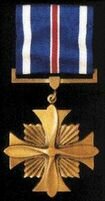|

Cu Chi Vietnam – “Tuck, listen to me. You can make it back to Cu Chi - you can and you will - I’ll help you.” These words, crackling over the air waves to a wounded pilot of B Troop, 3d Squadron, 17th Air Cavalry, helped to bring a dramatic helicopter mission to a successful completion.
The flight started out as just another routine observation mission for the pilot of the OH-6A Cayuse helicopter, Captain Joseph L. Tuck of Gleason, Tenn., and his observer, Private First Class Richard Edwards of Polkton, N.C.
Following them in a Cobra helicopter gunship were Warrant Officers William Kane and John A. Garrison, key figures in the drama awaiting the hunter-killer team as the two helicopters’ headed for the Saigon river 27 miles northwest of Saigon.
Under operational control of the 25th Infantry Division, their mission was to observe and engage enemy troops along the vital waterway leading into the nation’s capital.
Captain Tuck skimmed above the ground in his observation helicopter as the Cobra circled overhead. On a particularly low pass over the lush growth near the river bank, his rotor wash uncovered a camouflaged tunnel entrance.
Tuck banked his helicopter around for another pass and flew into a barrage of intense automatic weapons fire. One burst ripped through the cockpit hitting Tuck in the left leg, smashing two bones. Edwards was hit in the right leg and began bleeding heavily.
Unable to move the rudder pedals with his wounded leg, Tuck gave the controls of the damaged, but still flyable ship, to his observer. Edwards, already pale from shock and loss of blood, turned the ship towards the Cu Chi base camp 10 miles south.
Having unsuccessfully attempted to stop the heavy flow of blood from his wound, Tuck looked towards Edwards in time to see the PFC slump over the controls and throw the Cayuse into a suicidal plunge.
With rapidly failing strength, Tuck managed to pull the observer off the controls and recover the tiny Cayuse. He then got on the radio and called the Cobra for help.
Inside the Cobra’s cockpit, Garrison of Fayetteville, N.C., listened to the message and thought it over. Tuck said he wanted to land his ship. If he somehow managed to set the craft down without crashing, there was still no way the two-seater Cobra could pick up the two men from the jungle where a large number of Viet Cong troops were lurking.
Turning the controls over to Kane, from Fort Worth, Tex., Garrison said a silent prayer and began speaking slowly and firmly to Tuck.
“You must not land. Tuck, listen to me. You can make it back to Cu Chi. You can and you will - I’ll help you.”
Haltingly, Tuck’s pain-racked mind started responding to Garrison’s encouragements and instructions.
|
|
 Tuck, very weak from loss of blood, could not follow complicated flying instructions so Garrison gave him simple directions. Tuck, very weak from loss of blood, could not follow complicated flying instructions so Garrison gave him simple directions.
“Turn left Tuck. A little more . . . that’s it, keep going . . . OK. Now pull up Tuck. Pull up on the cyclic, you’re too low!”
Slowly the Cayuse gained altitude and the Cobra moved into a position directly above and behind the stricken craft. In that manner the two helicopters flew back to Cu Chi.
At one point the blood from Tuck’s leg shorted out the radio next to his seat and a hurried change to another set was made.
As the Cobra approached Cu Chi, Garrison called the tower and told them he was escorting in a crippled helicopter. Crash rescue trucks raced across the steel plates to take up standby positions near the landing strip while the traffic controller cleared the skies to give the crippled Cayuse every possible chance.
Tuck radioed one last message before concentrating all his remaining strength on landing the ship, “I’m going to bring her in on a sliding landing, wish me luck.”
The Cobra pilots, realizing that he was going to slide along the runway on the helicopters’ skids instead of trying to drop the craft straight down, kept their eyes glued to the Cayuse and waited. There was nothing more they could do.
Wobbling erratically, the Cayuse plummeted towards the ground. Several feet above the runway the helicopter flared up and swerved wildly to the left.
Garrison held his breath, sure that the tiny ship would flip over and disappear in a mass of flames.
At the last moment Tuck straightened the ship out and dropped it softly to the ground. Too weak to lift his arms and twist the knobs to shut off the engine, he grasped the handle of the emergency fuel cut-off and yanked it up before he collapsed.
Tuck remembers nothing of those last few minutes, but Kane, leaping out of the Cobra almost before it touched the ground was the first one to reach the craft. Feebly, Tuck motioned him towards the observer. The captain would not let anyone help him until Edwards was pulled out of the Cayuse.
In a war where supersonic jets have replaced the single engine bi-plane and “seat-of-the-pants” flying, the last outpost where courage and skill are the deciding factors is in the helicopter war over Vietnam.
Shortly after the historic mission Captain Joseph Tuck was awarded the Distinguished Flying Cross for gallantry.

Captain Joseph Tuck receives the Distinguished Flying Cross from Colonel James Smith, Deputy Commander of the 1st Aviation Brigade.
|
